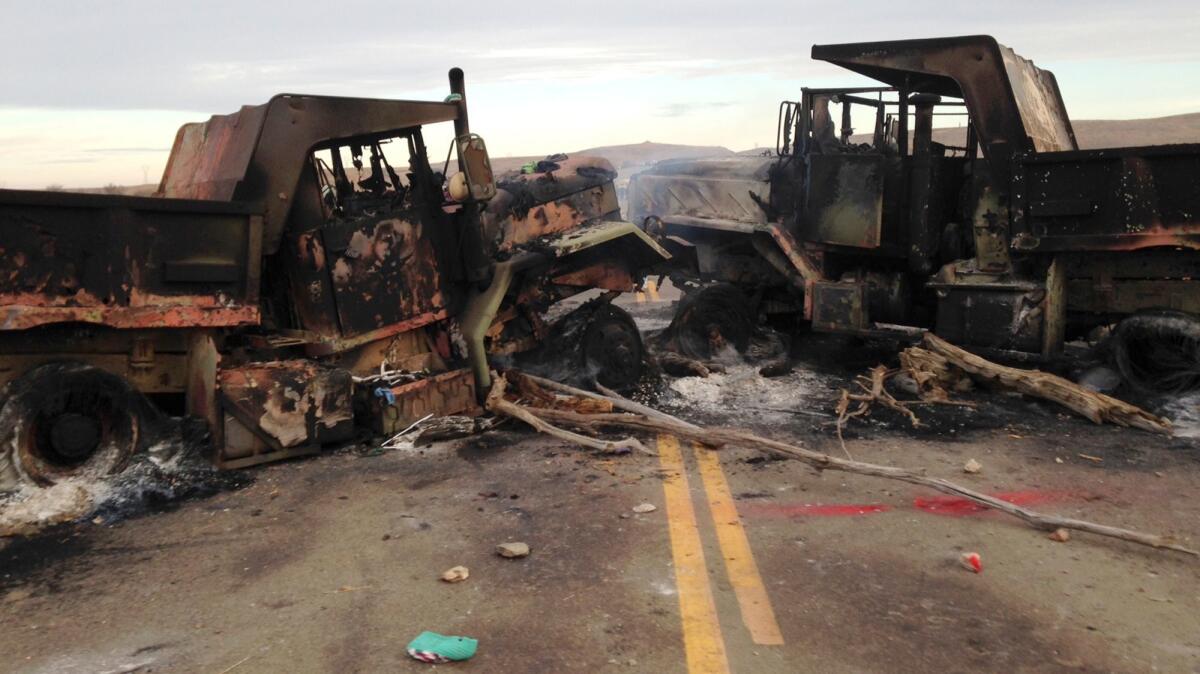North Dakota pipeline activists say arrested protesters were kept in dog kennels

On Oct. 22, North Dakota police arrested 126 people during what activists say was a peaceful prayer meeting at their encampment.
Reporting from Along the Cannonball River, N.D. — After a night of chaotic clashes with police on the front lines in a months-long protest, Native American activists complained about the force wielded to drive protesters from the path of a pipeline they contend will desecrate tribal lands and put their lone source of drinking water at risk.
Protesters said that those arrested in the confrontation had numbers written on their arms and were housed in what appeared to be dog kennels, without bedding or furniture. Others said advancing officers sprayed mace and pelted them with rubber bullets.
For the record:
9:48 p.m. June 23, 2019An earlier version of this article stated that the New Mexico National Guard helped clear the protesters. It was the North Dakota National Guard that was deployed.
“It goes back to concentration camp days,” said Mekasi Camp-Horinek, a protest coordinator who said authorities wrote a number on his arm when he was housed in one of the mesh enclosures with his mother, Casey.
At least 141 people were arrested Thursday after hundreds of police officers in riot gear, flanked by military vehicles releasing high-pitched “sound cannon” blasts, moved slowly forward, firing clouds of pepper spray at activists who refused to move.
Authorities claimed some protesters turned violent during the confrontation, setting fires, tossing Molotov cocktails and, in one instance, pulling out a gun and firing on officers.
Some of the activists claimed Friday that police had opened fire with rubber bullets on protesters and horses. One horse was euthanized after being shot in the leg, said Robby Romero, a Native American activist.
“They were shooting their rubber bullets at our horses,” he said. “We had to put one horse down,” he said.
Camp-Horinek said authorities entered the teepees that activists had erected in the path of the pipeline, a four-state, 1,200-mile conduit to carry oil from western North Dakota to Illinois.
“It looked like a scene from the 1800s, with the cavalry coming up to the doors of the teepees, and flipping open the canvas doors with automatic weapons,” he said.
Standing Rock Tribal Chairman David Archambault II called for a Justice Department investigation into the police tactics. Amnesty International announced Friday it was sending a human rights delegation to investigate and Sen. Bernie Sanders asked the White House to order the Army Corps of Engineers to temporarily halt construction of the pipeline.

“DOJ can no longer ignore our requests,” Archambault said in a statement. “If harm comes to any who come here to stand in solidarity with us, it is on their watch.”
Authorities have said all along that they have used restraint in the ongoing dispute and had pleaded for activists to retreat from the path of the pipeline and return to the camp where they have been gathered for months.
Most of those arrested were expected to be charged with criminal trespassing, engaging in a riot and conspiracy to endanger by fire, according to the sheriff’s department. Several fires broke out during the confrontation, and sheriff’s officials said seven protesters used “sleeping dragon” devices to attach themselves to vehicles or other heavy objects. The maneuver typically involves protesters handcuffing themselves together through PVC pipe, making it difficult for authorities to remove them using bolt cutters to break the handcuffs.
The protest in the rugged lands along the Cannonball River has lasted months as activists — sometimes hundreds, sometimes thousands — have assembled to decry the pipeline project.

But on Friday, with protesters cleared from the path of the pipeline, work was expected to resume on the $3.78-billion Dakota Access Pipeline, operated by the Fortune 500 company Energy Transfer Partners.
“When I left the bus in handcuffs, DAPL [Dakota Access Pipeline] trucks were lined up down the highway with construction equipment and materials waiting to come in and begin work,” said Camp-Horinek.
State and county police, the North Dakota National Guard and an oil company private security team cleared protesters, along with the teepees and tents they had erect in the path of the pipeline, and on Friday, authorities removed the final roadblocks that protesters had erected along the highway.
For the most part, protesters remained peaceful during Thursday’s confrontation, though at one point, an activist set fire to a heap of tires that were part of a blockade set up to impede the progress of advancing officers.
Sheriff’s officials said that one woman, while being arrested, pulled out a weapon and fired three rounds in the direction of the police lines. No one was hit, authorities said.
Activists denied that the woman fired the shots and claimed that sheriff’s officials previously had made erroneous reports about protesters’ actions, including passing along rumors of pipe bombs in the activists’ camp.
“The only gunshots that were fired would have come from them,” said Romero, one of the Native American activists. “They are armed. We are unarmed. They are trying to spin the narrative. They are using an increasingly vast military operation to respond to our spiritual resistance.
“They are fast-tracking the pipeline.”
With unimpeded access, pipeline crews could reach the Missouri River in a matter of days. The Obama administration has withheld final approval for the pipeline to cross under the river, on lands controlled by the Army Corps of Engineers.
Meanwhile, the Sheriff’s office said late Friday that Highway 1806 remained closed after “intense interactions” overnight, including what it called “multiple fires” on a bridge south of the now-vacated “Treaty Stronghhold Camp.”
Morton County Sheriff Kyle Kerchmeier said he was coordinating with Standing Rock officials to assist protesters in recovering teepees and other belongings, calling it a “a great example of communication, collaboration and cooperation.” He added: “I am very proud of our officers” who “responded with patience and professionalism and showed continuous restraint throughout the entire event.”
Despite the loss of their “Treaty Stronghold Camp,” which activists erected in recent days saying they were reclaiming land ceded to the Great Sioux Nation in the 1951 Fort Laramie treaty, activists vowed to fight on.
Tolan is a special correspondent.
ALSO
Even the Rev. Jesse Jackson on horseback can’t end pipeline showdown
Dakota Access oil pipeline protesters cleared from camp, sheriff says; more than 140 arrested
Clashes, arrests and fears — North Dakota pipeline protest at a boiling point
UPDATES:
2:37 p.m.: This articles was updated with details and quotes from the Morton County Sheriff’s office.
12:25 p.m.: This article was updated with details and quotes from a Native American protest coordinator.
This article was originally published at 11:45 a.m.
More to Read
Sign up for Essential California
The most important California stories and recommendations in your inbox every morning.
You may occasionally receive promotional content from the Los Angeles Times.










